Article's Content
Life is more fun when you’re the underdog competing against giants.
We all love a good underdog story. When it comes to software; the world of enterprise HR and payroll solutions is definitely filled with giants that seem unstoppable. Companies like ADP, Paylocity, Workday, Ceridian, and Quickbooks have captured the better part of this market for years and have held onto their leadership positions with excellence.
Combined these companies have a $266 billion dollar market cap.
That’s massive.
And then there are the underdogs. There are companies like Gusto which most recently was valued at $4B as a company serving more than 100,000 companies with payroll, health insurance, HR, and more. According to their Head of Marketing; more than 1% of all employers in the US are using Gusto with a net promoter score of 70+.
There are 5.5 billion small and medium sized businesses throughout the US that could benefit from Gustos services… But the top 3 payroll brands serve 45% of the category.
This isn’t going to be an easy battle for Gusto to win. But from a recent analysis of their growth and an increase in the amount of buzz surrounding their brand — there’s no question that they’re one of the incumbents that every major player in this space should be watching.
Here’s some of the key things driving growth for the Gusto team:
Creating Content That Aligns With Users Needs
It’s estimated that more than 6.4M people land on Gusto.com every single year from search alone. This traffic is also expected to represent less than 20% of their total traffic at large.
Here’s some of the other impressive metrics that Gusto boasts:
> Has captured more than 3.2M backlinks
> Most recently valued at over $3.8 billion
> Ranks for more than 180,000 phrases
> Serves over 100,000 companies
And the one thing that has played a role in all of these things?
Content.
Blog Posts Targeting Long Tail Search Terms
Over the last few months, I’ve seen an increasing number of marketers talk about how blogging is dead and newsletters are the new chief in town. I get the sentiment. There’s a ton of buzz around newsletters with the rise of Substack and the creator economy. But blogging still has an important role to play in the marketing industry and in the content marketing stack.
Does blog content generate and drive the same results as it did 3 years ago?
Well… Yes. It does. The key is to understand the fact that the game has simply changed. The algorithm games that we could play when Facebook was the wild wild west are no longer viable. You can’t just throw a clickbait title on a blog post and expect it to thrive. You can’t just wrap together a few random ideas and expect them to get shared like wildfire. The internet has grown up and the algorithms have adjusted with it. Thus, it’s more important than ever to adjust our approach to blogging rather than holding onto old habits and strategies.
The team at Gusto has implemented an SEO driven blog strategy to perfection. It’s estimated that their blog generates about 1,090,000 visits annually (and that’s on the rise). The most impressive part of this is that they’re beating many of their competition for phrases that they should have capitalized on years ago but didn’t.
Gusto brilliantly categorizes their blog by sections. One section is titled Payroll:
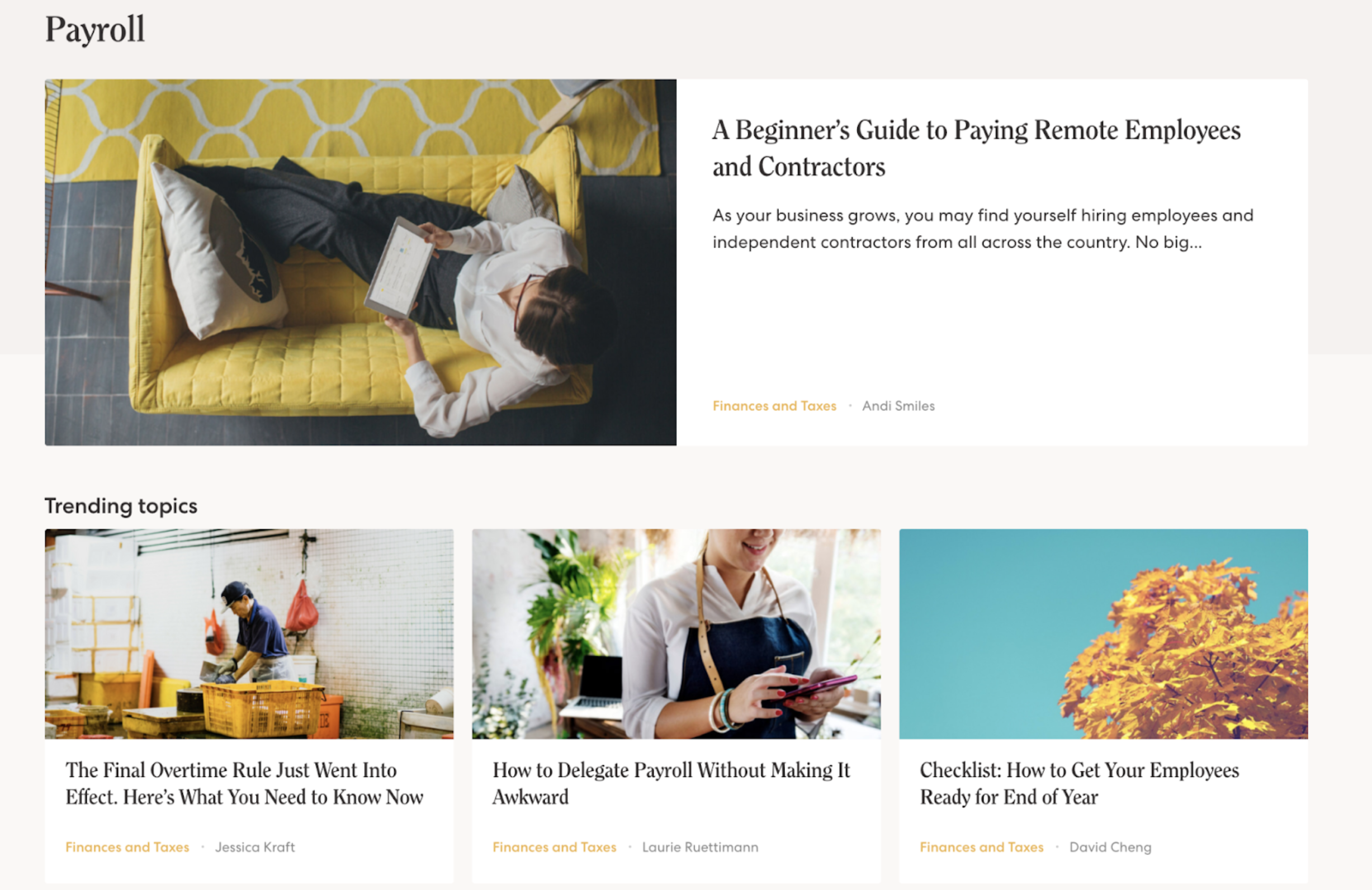

And as expected…
It covers Payroll specific topics.
At the time of this writing, there were 99 different posts published under the Payroll section. These blog posts accounted for 50,500 monthly visits to the Gusto website. That’s more than 600,000 visits per year targeting people who are looking for answers to questions surrounding payroll. This is where the brilliance of SEO and content marketing comes into play.
Gusto has created a handful of blog posts that speak directly to their customers’ needs and have optimized their site to capture the traffic. Blog posts including titles like:
- What is a Pay Stub?
- How to fill out a W4?
- What’s Imputed Income?
- The Difference Between Net Pay and Gross Pay
- What’s California State Disability Insurance (CASDI)?
But these assets don’t all look like blog posts. They look like informative information that a government website would bring to life and deliver to its constituents. Take the California State Disability Insurance blog post as an example:
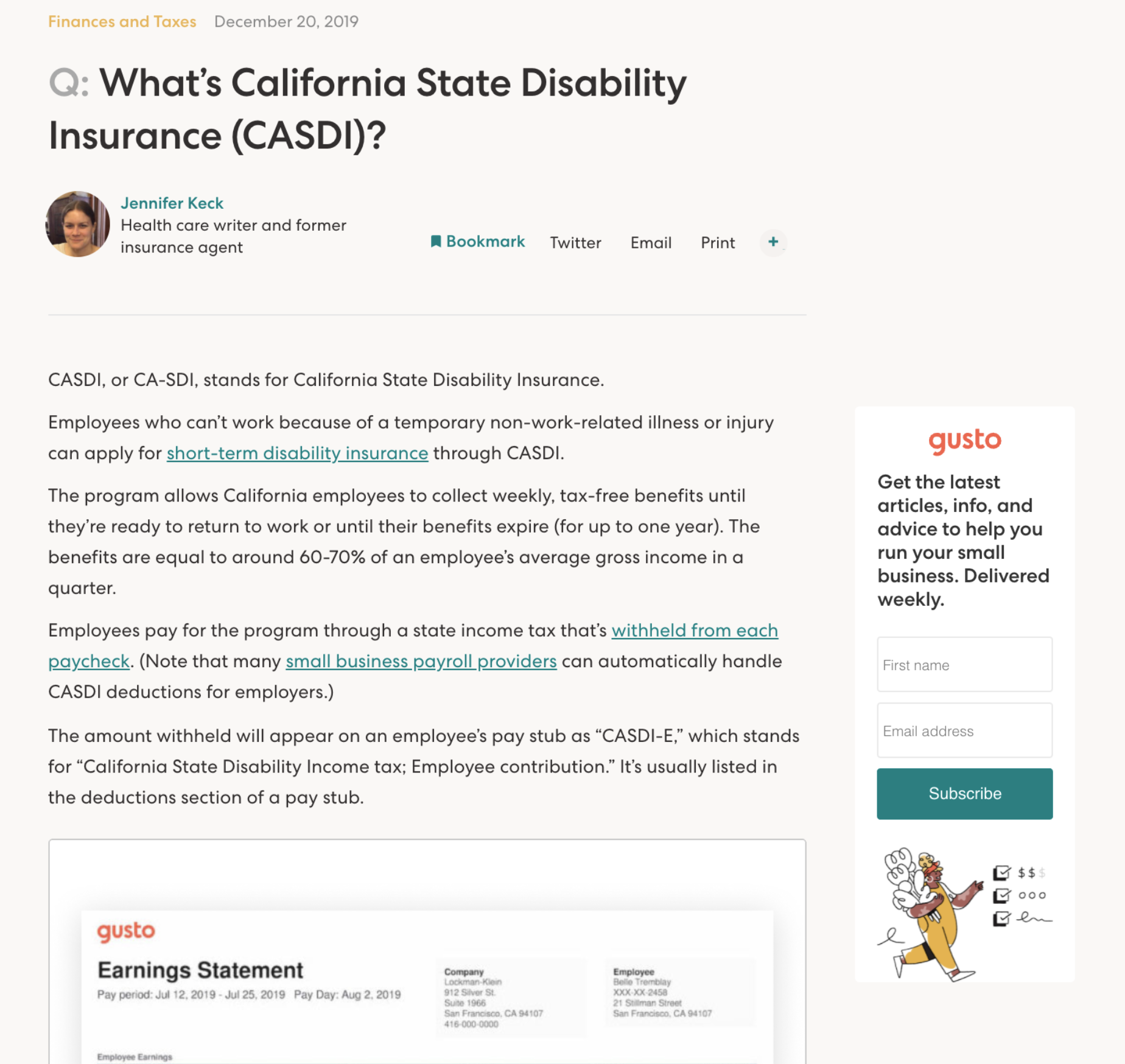

It’s a thing of beauty.
Sure it has the standard text on the left like a blog post but it places the name and experience of the author front and center. It also ensures that the “title” of the blog post is actually isolated in a sense by adding the Q: at the beginning of the H1. What does this do?
It gives the reader the impression that if there are any other questions they have about their payroll — they’ve landed in the right place. It gets better though. You can imagine someone landing on this page working in the payroll department for a company that just decided to move to California and is looking to better understand what they need to do to get started. As they scroll through this blog post, they get tons of valuable information but they’re also met with a call to action from Gusto asking them to get started for free:


The takeaway?
RUN YOUR OWN ADS!
While everyone is talking about how brands should become their own media company; somewhere along the lines we forgot how media companies pay the bills. It’s through ads. So as you start to capture organic traffic (or any other form of traffic) use it to your advantage.
If your audience is landing on your website to read content about your niche and industry. It’s not enough to clap your hands and celebrate because you have a couple visits. You also want to turn those visitors into customers. A great way to do that is to inject call-to-actions throughout your content asking people to try your product or at the very least…
Ask them to get notifications for your newsletter:


That’s right.
Gusto does that too.
When I say they’re not leaving your decision to stay connected with them to chance; I’m serious.
Engage Writers Who Create With Authority
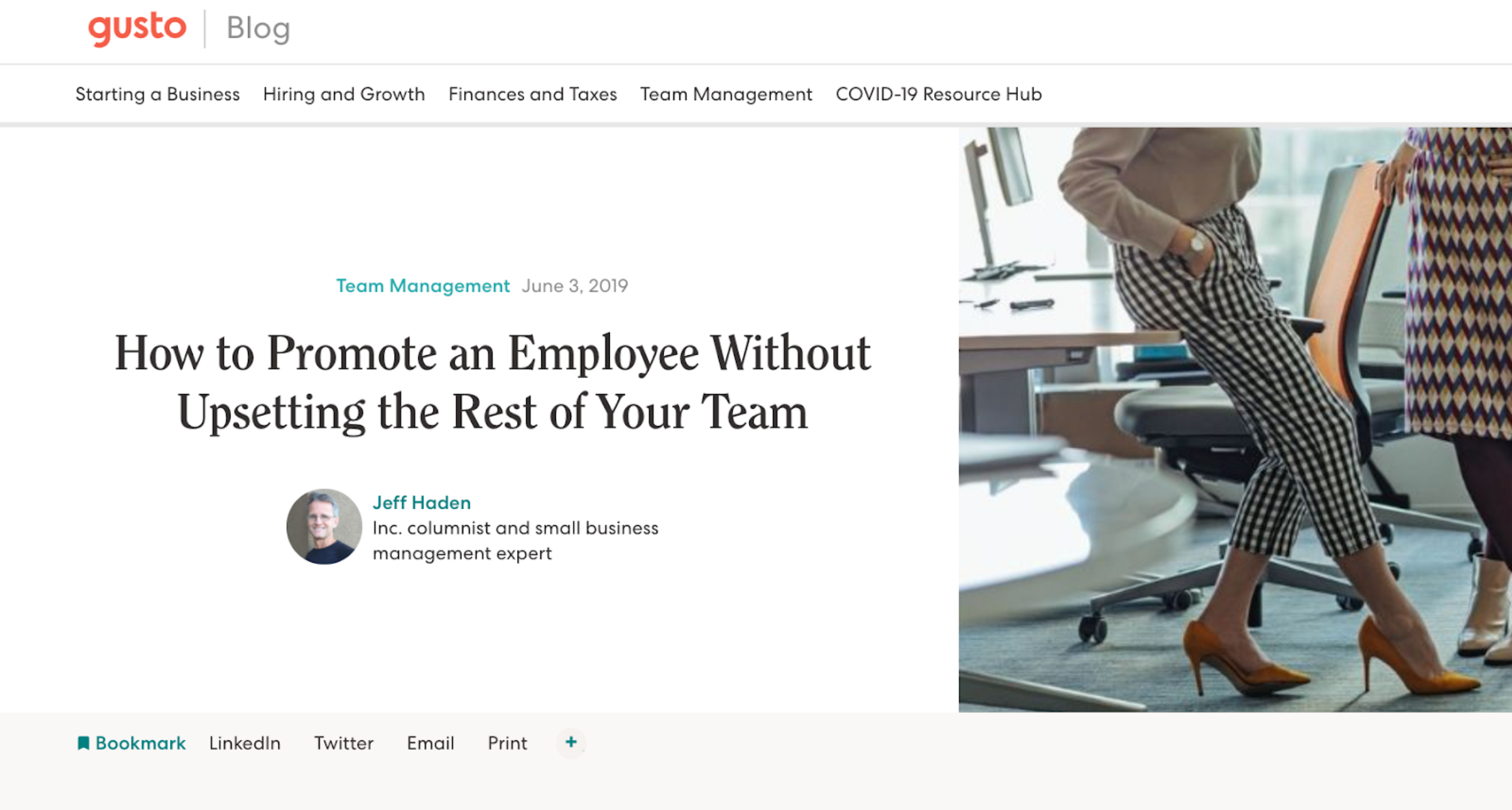

A mistake that many SaaS companies make is assuming that everything published on their blog needs to come from their full time team. It doesn’t. We’ve actively recruited and resourced writers from all walks of life, all different backgrounds, with a wide range of specialties (from PhDs to Scientists) to create content on behalf of clients and these assets always do well.
Why?
Because the author (if selected, recruited, and trained correctly) will bring a level of credibility and authority to the piece that most cannot. In addition, if you take a page out of Gusto’s book; you might even use an influencer who has already built a following of over 42,000 on Twitter and is likely to share the post with their community once it goes live. That’s right…
Influencer marketing in B2B… Say it ain’t so!
Yup. It works. More on that here.
Creating Tools That Solve Customers Problems
One of the best ideas I’ve read in the last few months is this: Smart companies try to commoditize their products’ complements. If you can do this, demand for your product will increase and you will be able to charge more and make more. – Joel Spolsky
But how do you do it?
Arbitrage.
You take things that people are okay to pay for and give them away for free.
Just like Gusto does with all these payroll calculators and tools:
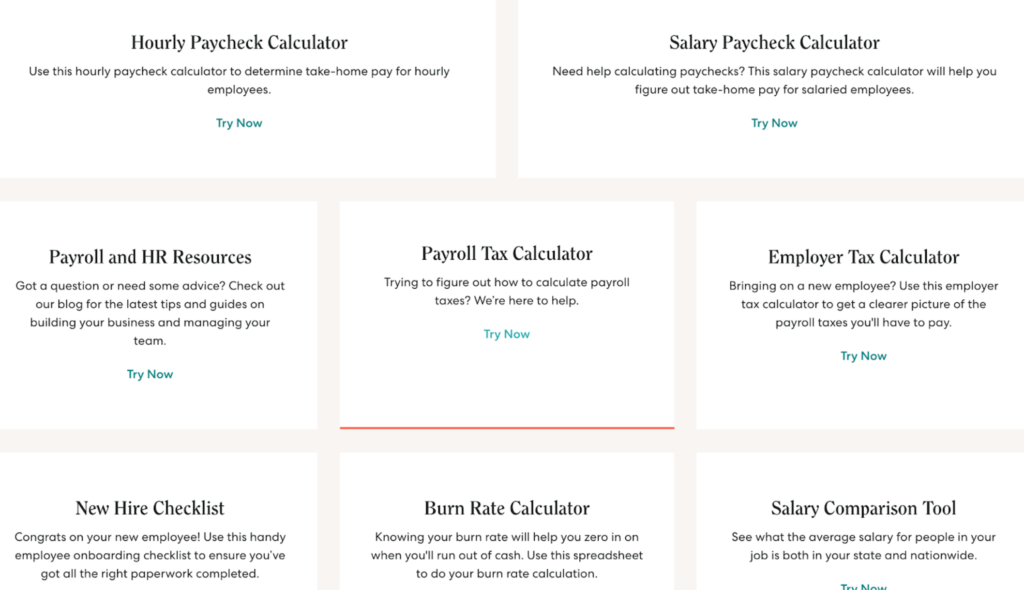

These checklists and calculators are things that companies used to have to pay to buy as templates online. In the last decade of tech, there were a handful of template directories that you could visit and buy templates from.
On the flip side, you could hire an expensive HR pro or lawyer to offer guidance around some of the questions you may have surrounding hiring, or you could just scroll through the endless amount of resources available for free on Gusto’s site. This is arbitrage at its finest.
But Gusto doesn’t stop there.
They localize the arbitrage as well.
This must be a complete nightmare for local HR folks. So much of their demand in the 90s would have come from people asking them for details, specifically around taxes in their local area. That’s gone. That pipeline of demand is quickly dwindling away thanks to Gusto publishing landing pages that provide custom payroll and paycheck calculations across every State:
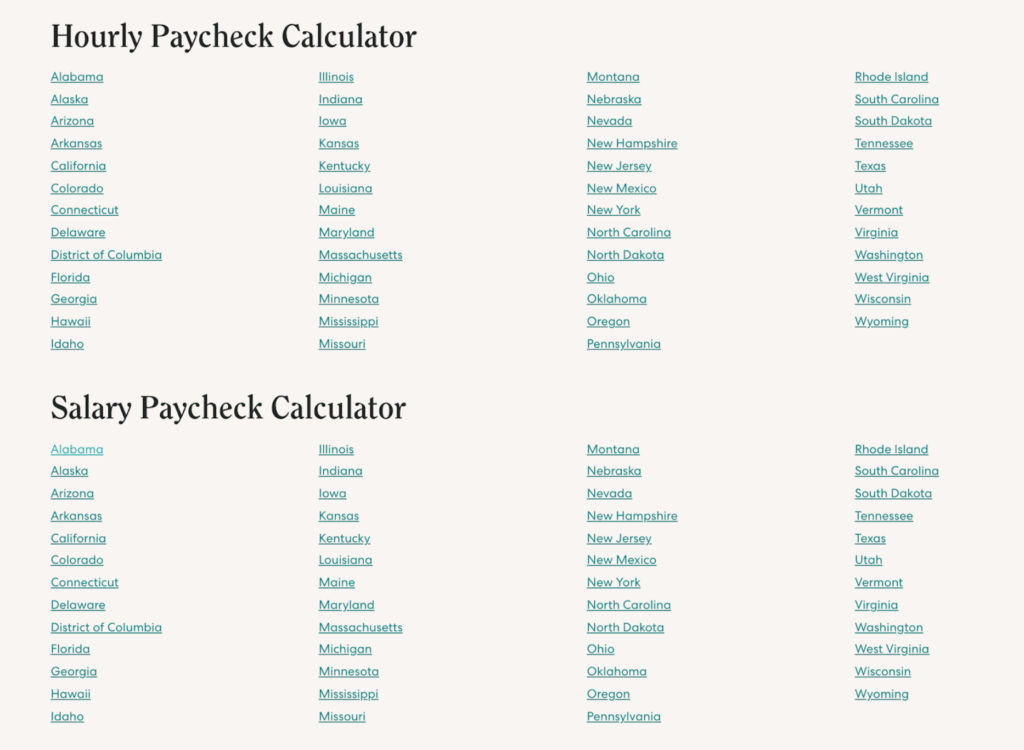

These calculators generate more than 601,000 visits every single year.
If you wanted to get these visitors through paid media:
You would have to pay $53,000 per month. But Gusto is able to capture that value organically by creating the assets once and optimizing them for search. This is why a content engine can provide B2B brands with a powerful (sometimes unshakeable) moat.
Creating A B2B Facebook Advertising Machine
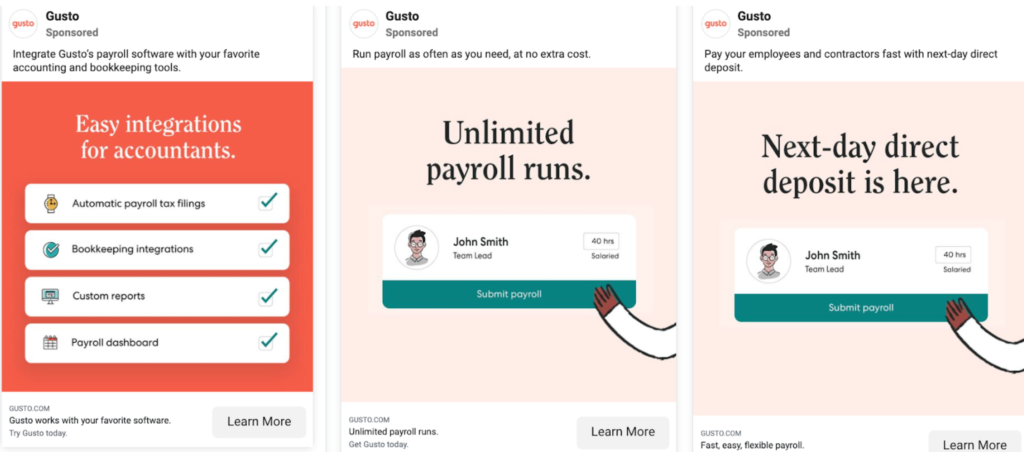

This might offend… But here it goes:
Twitter is the campus
TikTok is the dorm room
Instagram is the nightclub
Snapchat is the after party
LinkedIn is the conference room
Facebook is the retirement home
And while this idea is going to make a few people self-conscious (myself included) the truth is… Facebook has never been in a better position than now for B2B marketers to take advantage of. The audience that traditionally skewed young and irrelevant to B2B brands is now old (sorry, we just are) and in positions where they can make real business decisions. This reality has yet to flood the brainwaves of most B2B marketers but the team at Gusto has realized it.
In fact, over the last few years, the team has invested in paid advertising across multiple channels. From Google Ads to Facebook Ads — The Gusto team has invested hundreds of thousands of dollars in capturing their audience’s attention on the back of paid media.
One of the biggest challenges for a company like Gusto is the fact that their audience size is actually quite small. There aren’t hundreds of people working at small businesses with the job description Payroll… It’s usually just one person. Making them difficult to target and reach.
So instead of just going after that one single audience; Gusto made the decision to try and influence the influencers. That is… Influence the colleagues and employees at these companies with the intent of getting them to spread the word within their companies and push the actual decision makers into the funnel. Once in the funnel and identified as a clear decision maker; Gusto has the ability to leverage advertising efforts like remarketing to close the deal.
In 2018, the CEO & Founder of Growth Pilots (acquired) wrote about how his company helped Gusto build a B2B social advertising engine. He described the paid social strategy surrounding their full funnel advertising approach in Clearbit’s data driven marketing book and shared thoughts directly from Gusto’s acquisition lead, Dan Davidow. He wrote:
It takes quite a bit of time and education for a company to choose Gusto, especially if they’re a switcher or migrator, and they found that social ads have different uses at the top and at the bottom of their marketing funnel.
The acquisition lead at Gusto, Dan Davidow, took this a step further:
Gusto uses remarketing to accelerate demand. We know that people are doing comparison shopping. Remarketing helps us stay top of mind during the decision-making process, and if prospects aren’t there yet, we use remarketing to take them through a journey and show them what’s possible.
The strategy in a nutshell was described as this…
- Top of Funnel: Cast a wide net. Educate all employees at prospective businesses.
- Middle of Funnel: Get non-decision makers to sign up, spread the word to decision makers, and drive decision maker traffic to the site to build a remarketing audience.
- Bottom of Funnel: Remarket to decision makers aiming at conversion.
Today… This strategy still seems to be embraced at Gusto.
But it’s always been a bit more intelligent than most campaigns. Another factor that has helped Gusto thrive on the back of paid media is their utilization of event tracking and advertising.
Smart Tracking & Event Based Advertising
In the same article that shared the overarching remarketing effort – the team also shared how they use events and engagement to run specific campaigns to their audience. They wrote:
Facebook pixel event tracking lets you tie ads to specific events that happen on your website, like lead captures, visits to your Case Studies page, “add to cart” actions, purchases, and more.
For us, the trick was to map the key business metrics that are important to Gusto and map them to what we can track in Facebook—because then we got the benefit of being able to optimize for the Facebook algorithm and track important customer actions in real time.
The three events that Gusto focused on included:
- Lead capture: Someone on the Gusto website submits their email address to sign up for a (free) account and becomes a lead.
- “Add employee”: That lead adds an employee to their account—a major step in being able to actually run payroll and pay that employee.
- “Run payroll”: The account holder runs payroll to pay an employee. This is considered the final conversion step because at that point, Gusto charges a fee and the lead becomes a paying customer.
These are the north star metrics for their efforts.
Every SaaS has them.
You need to take the time to understand the metrics most important to your business and set up conversion/event tracking so you can run advertising campaigns that are prioritizing capturing traffic from those who are most likely to convert. The biggest takeaway that Soso Sazesh included in his chapter on social advertising for B2B and Gusto:
Pixel your website and track as many events as you can. Even if you only care about a subset of them right now, having the data available may be useful in the future, and it doesn’t hurt to collect it.
And I couldn’t agree more.
You can target people who visit your site by their actions and cross-reference that with things that are proprietary to Facebook like: Location, Demographics, Interests, Gender, Job Title, Education, Prior Purchases, Consumer Behaviors, Device Usage, Hobbies & more.
In a world where everyone likes to assume that Facebook doesn’t work for B2B; the smart brands realize this is a complete fabrication. The smart brands recognize that Facebook advertising offers the ability to use email lists, CRMs, and so much more to create stronger and more targeted ads. But the key here is taking the time to actually do it…
All of this takes time.
Not just the advertising efforts. But the content efforts we described as well. You don’t create a content moat overnight. You don’t create a collection of calculators that generate over 600,000 visits per year overnight. These things take time. And these things are an investment.
You know the saying.
Marketing is more like investing than most people think.
But if you’re already a believer in that sentiment. You’ve got an advantage. So use it.
Invest today. Shine tomorrow. I’m rooting for you.
Especially… If you’re the underdog. Go get’em.
Stay up to date with all of our latest findings by subscribing to our newsletter today. Signing up also gives you early access to Ross’ Tuesday essay full of exclusive industry insights.
Quick, do it now before the next drop!







